How a computer that 'drunk dials' videos is exposing YouTube's secrets
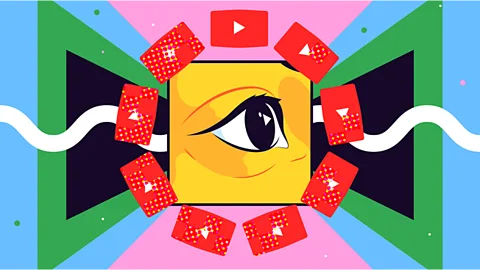 Estudio Santa Rita
Estudio Santa RitaYouTube is about to turn 20. An unusual research method is unveiling statistics about the platform that Google would rather keep hidden.
YouTube may not seem secretive. It's public facing. You can watch an endless stream of content from now until your dying breath. There's been a mountain of research about the platform, unpacking everything from the commodified economy that surrounds it to the radicalising effects of its algorithm. But the picture goes blurry when you start asking simple questions. For example: how much YouTube do we all watch?
Google, which owns YouTube, is quiet about that and many other details. In February, the company revealed that people who access YouTube on their TVs collectively watch one billion hours a day, but total numbers for the platform are an enigma. Estimates say YouTube has around 2.5 billion monthly users – almost one-in-three people on Earth – and the average mobile app user watches something like 29 hours a month. With that, let's try some back-of-the-napkin maths.
If we make a few assumptions, and say that monthly viewing average for app users can be applied across all YouTube users on both the website and television, we can multiply 2.5 billion by 29 hours. This would tell us that humanity consumes something like 8.3 million years of videos on YouTube every month. Over 12 months, that adds up to almost 100 million years, hundreds of times longer than the sum total of human history.
How many YouTube videos are there? What are they about? What languages do its users speak? YouTube launched on 14 February 2005, though the company prefers to celebrate 23 April 2005, the day the first video was uploaded. As of this month, people have been posting on YouTube for 20 years. That is a lot of videos, but we don't have even the simplest details about them. Google knows the answers. It just won't tell you.
YouTube turns 20
For more on the world's biggest video platform, read our stories on:
Experts say that's a problem. For all practical purposes, one of the most powerful communication systems ever created – a tool that provides a third of the world's population with information and ideas – is operating in the dark.
In part that's because there's no easy way to get a random sampling of videos, according to Ethan Zuckerman, director of the Initiative for Digital Public Infrastructure at the University of Massachusetts at Amherst in the US. You can pick your videos manually or go with the algorithm's recommendations, but an unbiased selection that's worthy of real study is hard to come by. A few years ago, however, Zuckerman and his team of researchers came up with a solution: they designed a computer program that pulls up YouTube videos at random, trying billions of URLs at a time.
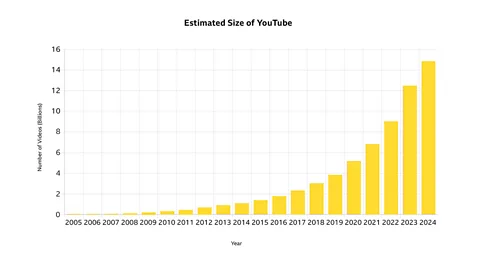 University of Massachusetts at Amherst/ Yun Sun Park/ BBC
University of Massachusetts at Amherst/ Yun Sun Park/ BBCYou might call the tool a bot, but that's probably overselling it, Zuckerman says. "A more technically accurate term would be 'scraper'," he says. The scraper's findings are giving us a first-time perspective on what's actually happening on YouTube.
In its 20 years of operation, YouTube has shaped entire generations' sensibilities and redefined global culture. Surveys show YouTube is the most popular social media site in the US by far, with 83% of adults and 93% of teenagers among its patrons. It's the second-most-visited website on Earth by most estimates, topped only by Google.com itself. But as the platform enters its third decade, the most basic facts about YouTube are still a closely guarded secret.
A Google spokesperson shared a blogpost about the platform's recommendation algorithm, but declined to comment on the statistics and other issues mentioned in this story. For now, YouTube's mysteries continue.
Unusual methods
"It's extremely difficult to get a grasp on what's going on inside social media platforms, because while the companies that operate them do make certain public disclosures, those disclosures are fragmentary and often somewhat misleading," says Paul Barrett, deputy director of the New York University Stern Center for Business and Human Rights. "I think there's an instinct at Google that it's not in their interest to emphasise just how gargantuan YouTube is, how titanic the number of users, how phenomenal the amount of content. Google doesn't want to be seen as influential as it really is."
But Zuckerman and his colleagues found a way to peek behind the curtain. YouTube URL's have a standard format. With a few exceptions, the addresses begin with "youtube.com/watch?v=" and end with a unique string of 11 characters. Gangnam Style's identifier is 9bZkp7q19f0, for example.
So, the researchers wrote a program that basically generates 11 random characters and checks if there's a corresponding video. When the scraper finds one, it downloads it. Zuckerman says you can think of it like a pesky teenager, punching in random numbers for prank calls after dipping into his parent's liquor cabinet.
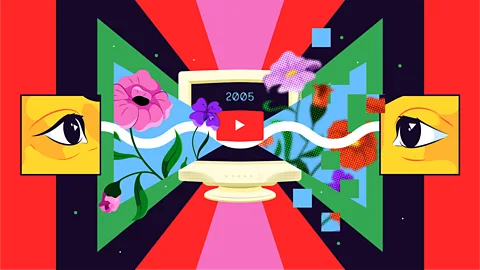 Estudio Santa Rita
Estudio Santa Rita"If I wanted to know how many valid phone numbers there are in New York's 212 area code, I could just dial 212 and seven random numbers to see if somebody answers. I'd probably get cursed out a lot if I did it enough, but eventually I'd gather enough data to figure it out," Zuckerman says. "That's what we did with YouTube. The thing is, YouTube has 18.6 quintillion potential numbers, so you have to dial a few billion before someone picks up."
So, Zuckerman's lab let the scraper drunk dial YouTube, over and over again, until it put together a big enough data set. To collect the first 10,016 videos they gathered for their initial study, the scraper tried more than 18 trillion potential URLs. It took almost 1.87 billion bad guesses for every real video it found. If you did that work yourself, spending three seconds on each try, it would take an average of 178 years before you landed on a single video.
When the researchers analysed their findings, the results challenged the prevailing narrative about what YouTube actually is.
Secret stats
The first question was simple. How many videos have people uploaded to YouTube? Google used to release that statistic in the early days, back when YouTube had something to prove. When Google first acquired the platform in 2006, around 65,000 videos were uploaded every day. More recently the company says more than 500 hours are uploaded per minute, but it's tight-lipped about the number of videos.
Zuckerman and his colleagues compared the number of videos they found to the number of guesses it took, and arrived an estimate: in 2022, they calculated that YouTube housed more than nine billion videos. By mid 2024, that number had grown to 14.8 billion videos, a 60% jump.
For many, YouTube brings to mind the faces of bright-eyed influencers vying for money and fame, or professional content creators like MrBeast or Joe Rogan. But the researchers then took a subset of the videos and had human reviewers watch each one to answer a series of questions about what they saw. For the most part, they didn't find the work of professionals.
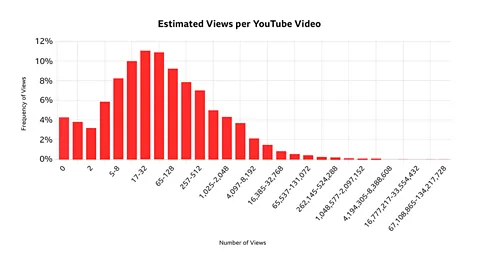 University of Massachusetts at Amherst/ Yun Sun Park/ BBC
University of Massachusetts at Amherst/ Yun Sun Park/ BBCOnly 0.21% of the videos they analysed featured any kind of monetisation, such as a sponsorship or an advertisement in the video itself. Less than 4% of the videos included a call to action like YouTube's famous invitations to like, comment and subscribe.
Those with some kind of set or background design accounted for 14% of videos, while only 38% had undergone any form of editing. More than half of the videos had "noticeably shaky" camera work. Only around 18% of videos we're judged to have high quality sound, and the sound quality varied significantly almost 85% of the time. More than 40% had just music, and no speech. About 16% of videos in the sample were primarily still images.
The top YouTubers attract audiences in the hundreds of millions, but the researchers estimated the median YouTube video has just 41 views, and a full 4% of videos haven't been watched a single time. About 74% of videos have zero comments. Around 89% have no likes. Typical YouTube videos aren't just getting little attention; it seems, they're also very short. They assessed that the median length for a YouTube video is only 64 seconds, and more than a third of videos are less than 33 seconds.
Troubling questions
YouTube once sold itself as a tool for regular people. The company's early slogan was "broadcast yourself". But today, YouTube suggests it's more of a service for people to watch the work of professional creators. In his annual letter at the start of 2025, YouTube's chief executive Neal Mohan said the company's mission is still to "give everyone a voice" – but most of the message was a discussion about how "YouTubers are becoming the start-ups of Hollywood" and "YouTube is the new television".
This narrative misses a critical piece of the picture, says Ryan McGrady, the senior researcher in Zuckerman's lab, who participated in the scraping project. YouTube is a free service that was built from the ground up by a private company, and it could be argued that Google should be able to run the platform as such. But when you examine how people are actually using YouTube, it looks less like TV and more like infrastructure, McGrady says.
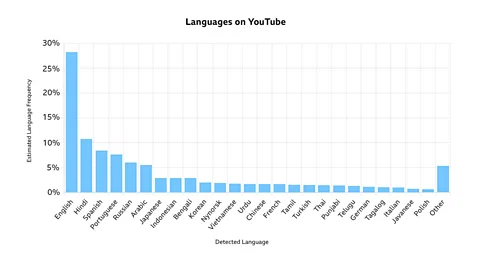 University of Massachusetts at Amherst/ Yun Sun Park/ BBC
University of Massachusetts at Amherst/ Yun Sun Park/ BBC(To identify languages, the researchers used speech recognition software called Whisper. It paints a fairly accurate picture, but makes occasional errors. For example, Whisper sometimes identifies unintelligible sounds as Nynorsk, a written-only language in Norway.)
"Most of us imagine YouTube as this place where millionaires give away prizes in a Squid-Game-style contest," he says. "But when you want to have a conversation about YouTube and its place in our society, we need to look at the ways it's used, not just the ways it's consumed."
YouTube is one of the internet's de facto repositories, the first place many of us go when we have videos we want to post or store online. It's also a place where local authority meetings are broadcast, for example, providing a vital opportunity for public accountability in ways that weren't possible before it existed. YouTube isn't just a "platform", McGrady says, it's a critical piece of infrastructure, and that's how it should be regulated. "For companies that own so much of our public sphere, there are some minimum expectations we should have about transparency."
Google is dealing with more regulatory pressure than ever before. In the past year, US courts found the company runs two different illegal monopolies in both the search engine and digital advertising businesses. As Google battles to lessen the consequences it will face, the company is fighting a number of other antitrust lawsuits across the globe.
But YouTube has escaped much of the scrutiny that's challenged its biggest social media competitors, according to Barrett of New York University. Mark Zuckerberg and Elon Musk make frequent, loud pronouncements about how they do business and what's happening on their platforms. "Google, in contrast, has largely stayed out of the crossfire by choosing a strategy of being much quieter, a strategy I'd say has largely worked for them," he says.
"Social media is an anomaly when it comes to how little companies need to explain themselves if you compare it to other industries like finance, or agriculture or even broadcasting," Barrett says. "But social media companies are fundamental players not just in mass communication but in all matters of political and civic life."
The most important thing to understand is the inner workings of YouTube's algorithm, a system that has astronomical power over the distribution of information all over the world, Barrett says. But simple details about what happens on the platform are important as well. "It would be very valuable to know all of the facts that are currently so shrouded and unavailable. They are the building blocks of doing deeper research," he says. "It only takes you so far, but you've got to start someplace. The more basic information we have to assess, the healthier the public debate about the role of social media in society will be."
--
This article was originally published on 13 February 2025, and updated on 20 February 2025 with additional information about the software researchers used to classify langauges. It was updated on 23 April 2025 with details about YouTube's anniversary and rulings in Google's antitrust lawsuits.
For more technology news and insights, sign up to our Tech Decoded newsletter, while The Essential List delivers a handpicked selection of features and insights to your inbox twice a week.
